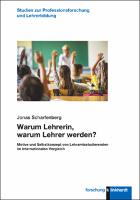Warum Lehrerin, warum Lehrer werden?
Motive und Selbstkonzept von Lehramtsstudierenden im internationalen Vergleich
Abstract
This study examines (1.) which career choice motives influence the career choice of future teachers and whether the career choice motives of future teachers from Germany, Sweden, Romania and the U.S. differ from each other, (2.) whether these motives are connected to other personal attributes of future teachers (e.g. self-efficacy) and (3.) whether varying systemic influences (e.g. policy decisions) can help explain why career choice motives vary between different countries.
The study uses a mixed-methods design. First, a confirmatory factor analysis with measurement
invariance analysis confirms a model consisting of 16 career choice motives that can be measured across the four countries. The model includes nine intrinsic, four extrinsic and three pragmatic motives. Career choice motives differ significantly across countries: American participants achieve the highest intrinsic, German participants the highest extrinsic and Romanian participants the highest pragmatic values. Swedish participants show a heterogeneous profile.
Second, a cluster analysis shows three distinct career profiles of future teachers that can be observed in all participating countries. A comparison between the career choice motives and other personal attributes like self-efficacy shows that a purely intrinsic motive profile is more functional than a motive profile that includes extrinsic or pragmatic elements as well. However, effect sizes stay small. A cluster consisting of purely extrinsically motivated future teachers could not be found – extrinsic and intrinsic motives seem to complement each other rather than to be in competition.Third, it is possible to identify relevant aspects of the professional environment that are connected to the career choice motives of future teachers. Participants describe, for example, how the likelihood of peers or parents recommending the profession varies depending on the salary, the overall attractiveness and the reputation of the career. Furthermore, working conditions and the bureaucratic workload of teachers influences subject-related intrinsic motivations. Higher level factors of influence include politics & policy, university, societal factors and other stakeholders. Modifying the professional environment of future teachers, those factors can have an influence on their career choice motives as well. Educational reforms, for example, can shape the range of professional tasks that teachers are required to do, while changes in the structure of the professional training programs can shape how easy it is to become a teacher.
Using these results, it is possible to find concurrences between the differences in the professional environment and the career choice motives of future teachers from different countries. The results show how societal factors, politics, but also universities and in the end teacher training programs themselves can have an influence on who wants to become a teacher – and why: Especially the influence of teacher training programs highlights the need for further professionalization of the field. Die vorliegende Studie untersucht, welche Motive bei der Studien- und Berufswahl von Lehramtsstudierenden relevant sind, inwiefern sie mit Aspekten ihres Selbstkonzeptes zusammenhängen und inwiefern sich die Motive von Lehramtsstudierenden verschiedener Länder unterscheiden. Ausgehend von den theoretischen Annahmen sog. Person-Environment-Fit-Modelle beleuchtet sie Unterschiede in den Motivausprägungen deutscher, schwedischer, rumänischer und amerikanischer Lehramtsstudierender und analysiert, inwiefern diese Motive mit wahrgenommenen Aspekten der beruflichen Umgebung in Beziehung gesetzt werden können. Neben spezifischen Unterschieden in den Motivausprägungen der Studierenden aus den einzelnen Untersuchungsländern zeigt sich dabei, dass nicht nur sozioökonomische Faktoren, sondern bspw. auch die Arbeits- und Ausbildungsbedingungen, das wahrgenommene Aufgabenspektrum von Lehrpersonen oder das Ansehen des Berufs mit den Studien- und Berufswahlmotiven von Lehrkräften in Verbindung gesetzt werden können. (DIPF/Orig.)
Keywords
Lehrer; Lehrberuf; Berufswahl; Motivation; Studienwahl; Lehramtsstudent; Selbstkonzept; Internationaler Vergleich; Einflussfaktor; Berufsbelastung; Arbeitsumgebung; Innere Motivation; Äußere Motivation; Pragmatismus; Berufsbild; Lehrerausbildung; Wahrnehmung; Quantitative Forschung; Qualitative Forschung; Interview; Fragebogenerhebung; Studie; Deutschland; Schweden; Rumänien; USA; Teacher; Apprenticeship trade; Teaching profession; Career Choice; Occupational choice; Choice of studies; Student teachers; Self concept; Cross-national comparison; International comparison; Pragmatism; Career profile; Occupational image; Occupational profile; Teacher education; Teacher training; Perception; Quantitative research; Qualitative research; Questionnaire survey; Germany; Sweden; RomaniaDOI
10.35468/5759ISBN
9783781523241, 9783781557598, 9783781523241Publisher
Verlag Julius KlinkhardtPublication date and place
Bad Heilbrunn, 2020Series
Studien zur Professionsforschung und Lehrerbildung,Classification
Education
Teacher training


 Download
Download Web Shop
Web Shop